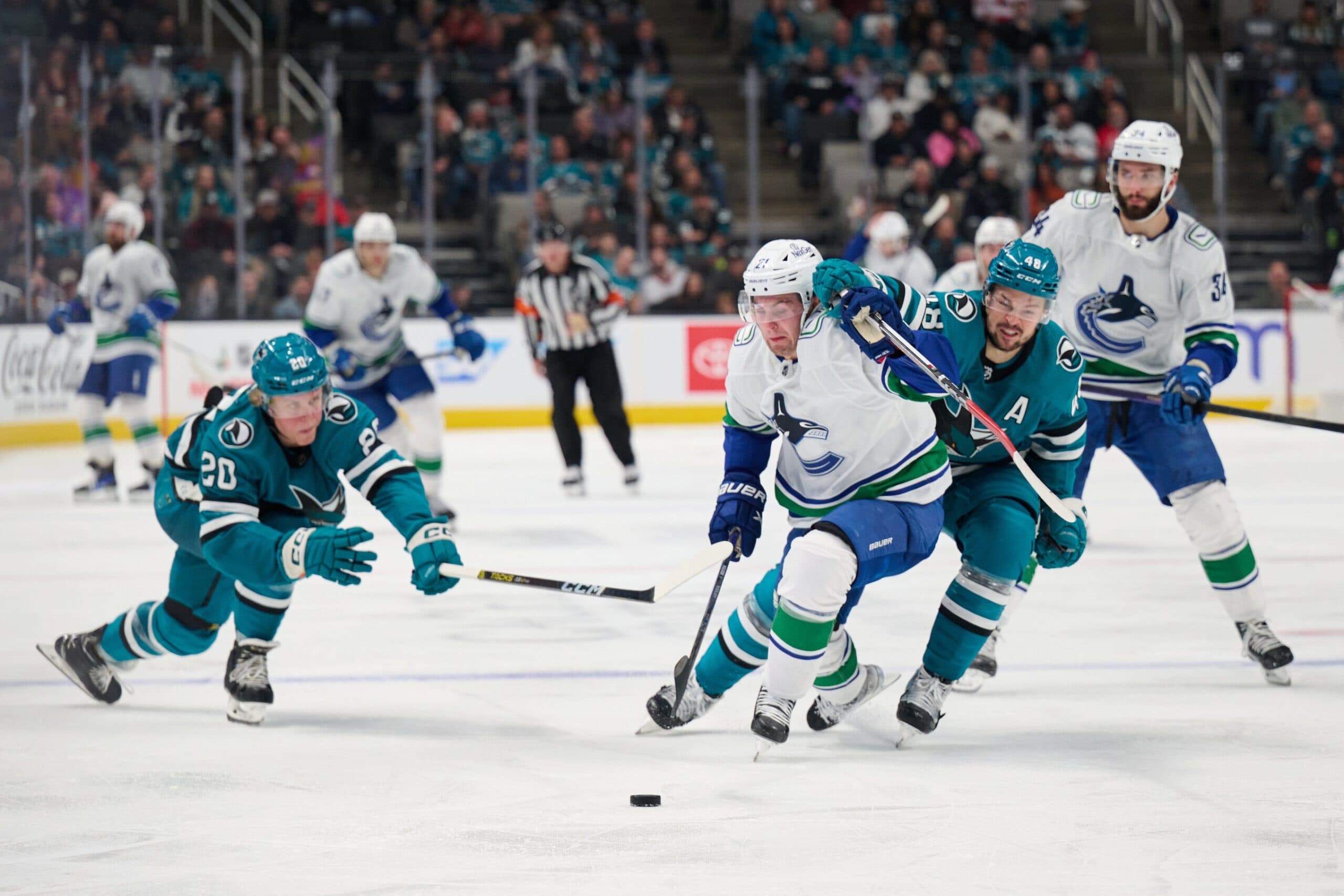Check the ‘Miscellaneous’ tab on NHL.com, where the league hides all its most questionably-tracked stats, and you won’t see Nils Höglander’s name too high on any lists, especially not those that attempt to measure physicality.
In terms of raw hit totals, his 14 hits through 20 games ranks him just 12th overall on the Vancouver Canucks. Even if one measures by minute, where Höglander usually shines, his 3.97 hits-per-60 ranks even lower at 13th overall, sandwiched right between Carson Soucy and Elias Pettersson.
All of which makes us pretty nervous to head into an article in which we attempt to argue that Höglander is showing signs of developing into some new-age version of a power forward.
And yet, it’s not always about how many hits one throws, but about how much of an impact one makes in doing so. On that front, it’s hard not to notice the evolution in Höglander’s game.
Höglander has always been surprisingly solid on his skates. It’s that low center-of-gravity, and it allows him to protect the puck — and himself — with little more than the application of some clever body positioning.
It’s when Höglander turns that low center-of-gravity outward however, and transforms it into an offensive weapon, that opponents really take notice.
As Brandon Tanev no doubt did when Höglander caught him at center ice with perhaps the stiffest check of the Canucks’ season thus far:
For those keeping track of the vital statistics at home, that’s a 5’9” Höglander meeting with a 6’0” Tanev and leaving the former devastated in his wake. There’s no charge here, there’s no pop. There’s barely a stride. There is just Höglander lowering the shoulder and the boom, and Tanev being sent flying as a result.
And while this was no doubt Höglander’s singular largest physical impact on the season, this is hardly an isolated incident.
We’re not going to sit here and celebrate a slewfoot that could have resulted in a serious injury and did result in a hefty fine. But we will point out that it resulted from an incident in which Kevin Labanc attempted to engage Höglander physically first, and was then plainly and cleanly outmuscled on the play.
The lesson being that when opponents go shoulder-to-shoulder with Höglander, they almost always walk away the loser. Even when they’ve got him beat on both height and weight.
This is nothing new, either. We all remember the Derek Forbort incident from Höglander’s rookie days.
What fewer may remember is that when the 6’4”, 215lb Forbort attempted to reef Höglander down to the ice in retaliation later that game, he was unable to until approximately six other players had hopped onto the pile.
That’s some serious stability.
The edge, and in particular the edge shown toward those poor fools who attempt to check Höglander, goes all the way back to his time in the SHL.
Of course, there’s a lot more to being any sort of power forward than just throwing hits. No one ever called Matt Cooke or Darcy Hordichuk a power forward. There are also elements of bodily puck protection, drives to the net, and finishing ability as basic requirements, and those are all elements that Höglander is displaying in ample abundance in 2023/24.
Observe as he slices through traffic and pushes the puck toward (and into the net).
Gaze in amazement as he picks up the puck down low, bears down with his body, and takes it to the front.
Watch him snipe.
There’s something to be said about even a pseudo-power forward who is capable of forcing his way to the dangerous areas on the ice if need be, but is also small and shifty enough to get there undetected when the opportunity arises.
Look, we’re not here to suggest that Höglander is going to suddenly transform into a lean, mean aggression machine. He’ll never be a power forward of yesteryear, like a Cam Neely or a Brendan Shanahan.
But such power forwards are of yesteryear because there aren’t many around anymore. There’s Tom Wilson and the Tkachuks, sure, but they’re more the exception that proves the rule. Every other modern power forward is some blend of that old physicality and the new skill, and that’s what Höglander continues to bring to the table in greater frequency and impact.
In fact, we hate to draw comparisons between a legendary player and someone still making their name in the NHL, but there’s at least some obvious similarities between the playstyle of Höglander and one notable Swedish power forward of the past, and that’s Peter Forsberg.
No, Höglander isn’t as talented, or as productive, or even anywhere near as mean. But what Höglander does share with Forsberg is that tenacious passion for hanging on to the puck, and that willingness to throw his body around with controlled, not reckless, abandon in order to maintain that possession.
A player just holding on to the puck and holding the opposition off with their shoulders and hips doesn’t make many highlight packages, and it can be tough to find clips online to support this assertion. But we probably don’t have to. Close your eyes, and try to imagine Höglander engaging in some dogged puck-protection, and it won’t be that difficult to picture. It’s something he does on a very regular basis.
And it’s the business of a power forward. Or, at least someone close enough to that distinction to count in this modern National Hockey League.
Don’t agree with the label? That’s fine. The point is that Höglander’s newfound impact on the ice goes well beyond the scoring, even as impactful (2.06 goals-per-60!) as that scoring has been.
He’s not leading in hits or hits-per-60. But he might just be leading in “making a difference with his body,” and that should count just as much.


